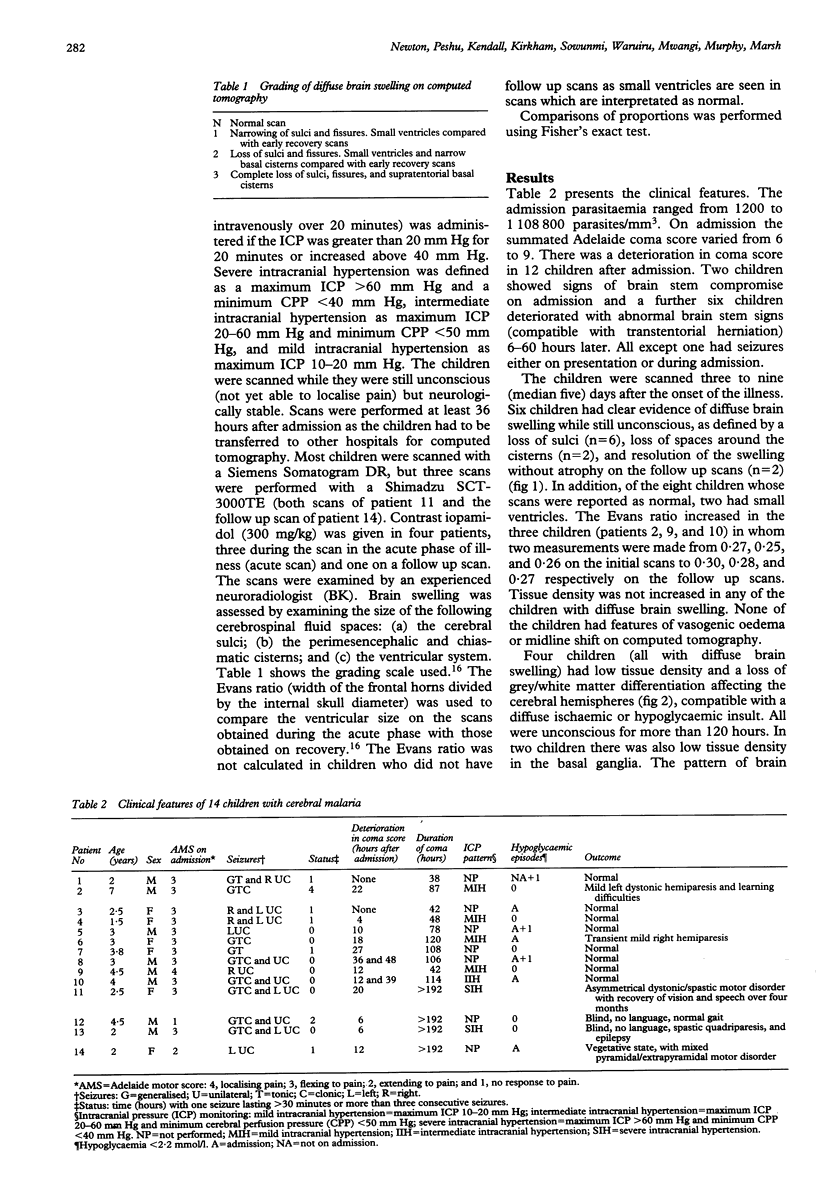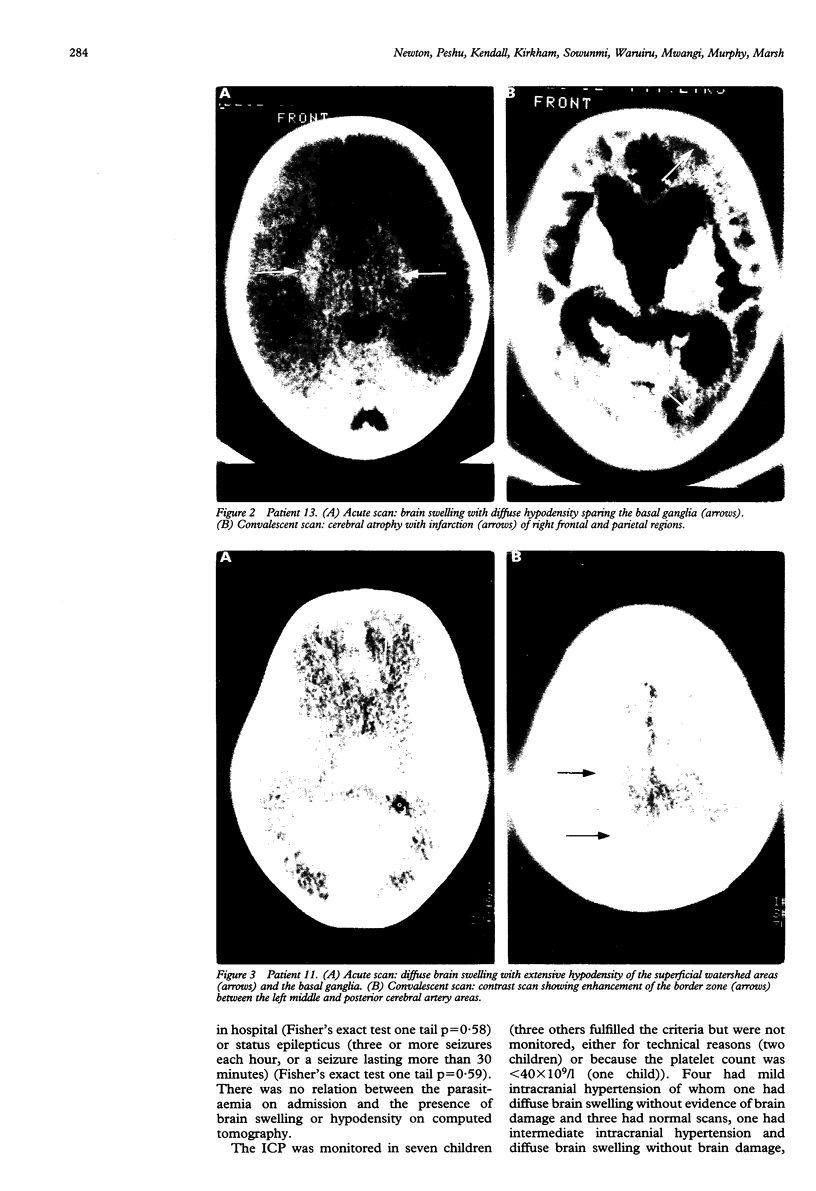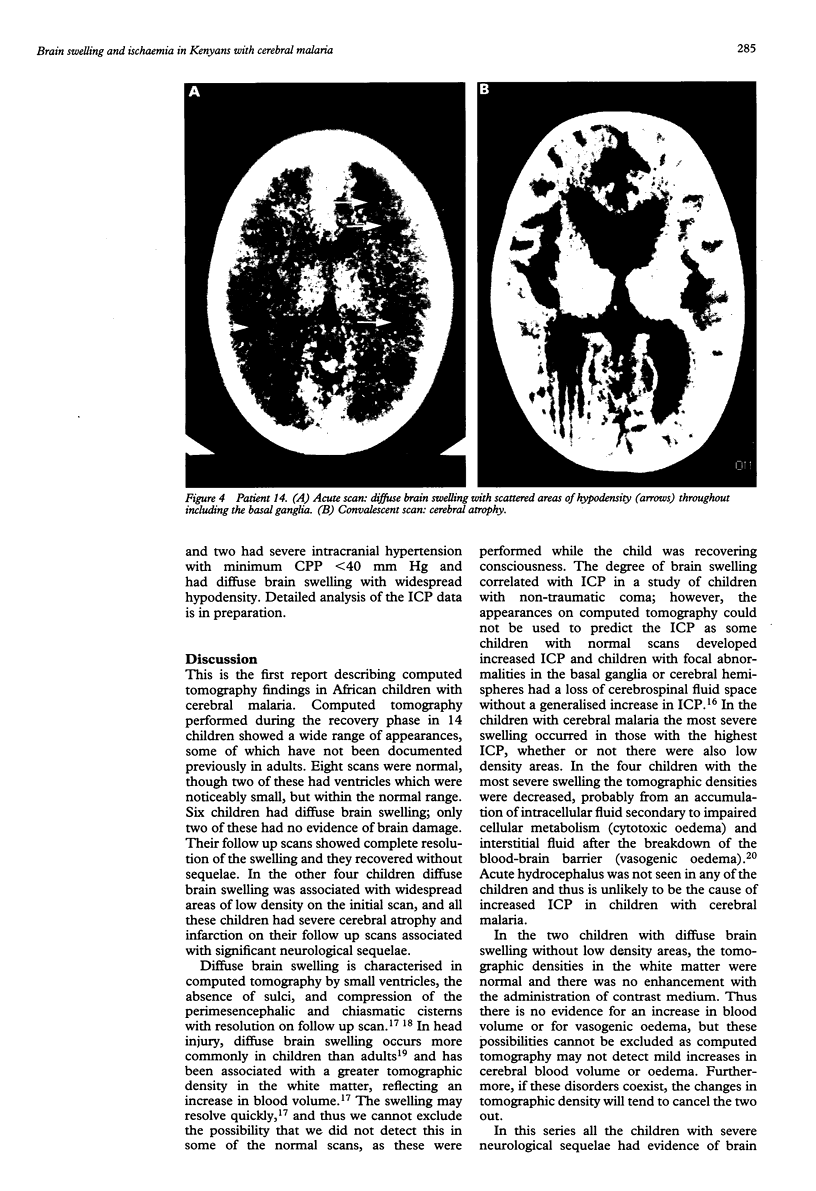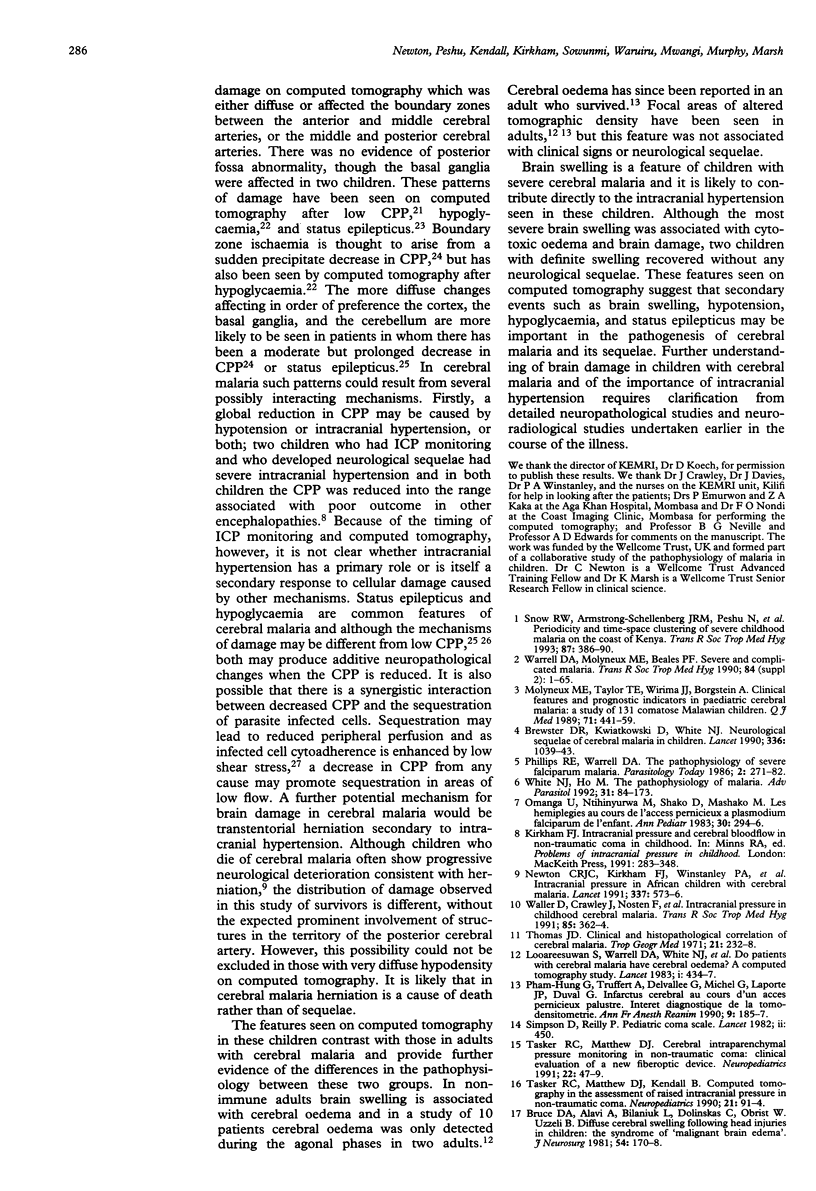Abstract
Computed tomography was performed on 14 unconscious Kenyan children recovering from cerebral malaria (seven of whom had another scan 12-120 days later) to elucidate the cause of intracranial hypertension and neurological sequelae. Brain swelling, defined as a loss of cerebrospinal fluid spaces, was documented in six children, while a further two had conspicuously small ventricles only. There was severe intracranial hypertension in the two children with definite brain swelling in whom intracranial pressure was monitored. There was no evidence of acute hydrocephalus or vasogenic oedema. Four children with brain swelling also had widespread low density areas suggestive of ischaemic damage. The patterns of damage were not uniform but were consistent with a critical reduction in cerebral perfusion pressure (which was documented in the two in whom this was monitored), hypoglycaemia, or status epilepticus. All four had serious neurological sequelae. These data suggest that brain injury in cerebral malaria may be due in part to secondary systemic and intracranial factors as well as to the direct effect of intravascular sequestration.
Full text
PDF






Images in this article
Selected References
These references are in PubMed. This may not be the complete list of references from this article.
- Adams J. H., Brierley J. B., Connor R. C., Treip C. S. The effects of systemic hypotension upon the human brain. Clinical and neuropathological observations in 11 cases. Brain. 1966 Jun;89(2):235–268. doi: 10.1093/brain/89.2.235. [DOI] [PubMed] [Google Scholar]
- Aicardi J., Chevrie J. J. Consequences of status epilepticus in infants and children. Adv Neurol. 1983;34:115–125. [PubMed] [Google Scholar]
- Aldrich E. F., Eisenberg H. M., Saydjari C., Luerssen T. G., Foulkes M. A., Jane J. A., Marshall L. F., Marmarou A., Young H. F. Diffuse brain swelling in severely head-injured children. A report from the NIH Traumatic Coma Data Bank. J Neurosurg. 1992 Mar;76(3):450–454. doi: 10.3171/jns.1992.76.3.0450. [DOI] [PubMed] [Google Scholar]
- Brewster D. R., Kwiatkowski D., White N. J. Neurological sequelae of cerebral malaria in children. Lancet. 1990 Oct 27;336(8722):1039–1043. doi: 10.1016/0140-6736(90)92498-7. [DOI] [PubMed] [Google Scholar]
- Bruce D. A., Alavi A., Bilaniuk L., Dolinskas C., Obrist W., Uzzell B. Diffuse cerebral swelling following head injuries in children: the syndrome of "malignant brain edema". J Neurosurg. 1981 Feb;54(2):170–178. doi: 10.3171/jns.1981.54.2.0170. [DOI] [PubMed] [Google Scholar]
- Iwai A., Sakamoto T., Kinoshita Y., Yokota J., Yoshioka T., Sugimoto T. Computed tomographic imaging of the brain in after hypoglycemia coma. Neuroradiology. 1987;29(4):398–400. doi: 10.1007/BF00348923. [DOI] [PubMed] [Google Scholar]
- Kjos B. O., Brant-Zawadzki M., Young R. G. Early CT findings of global central nervous system hypoperfusion. AJR Am J Roentgenol. 1983 Dec;141(6):1227–1232. doi: 10.2214/ajr.141.6.1227. [DOI] [PubMed] [Google Scholar]
- Looareesuwan S., Warrell D. A., White N. J., Sutharasamai P., Chanthavanich P., Sundaravej K., Juel-Jensen B. E., Bunnag D., Harinasuta T. Do patients with cerebral malaria have cerebral oedema? A computed tomography study. Lancet. 1983 Feb 26;1(8322):434–437. doi: 10.1016/s0140-6736(83)91437-x. [DOI] [PubMed] [Google Scholar]
- Molyneux M. E., Taylor T. E., Wirima J. J., Borgstein A. Clinical features and prognostic indicators in paediatric cerebral malaria: a study of 131 comatose Malawian children. Q J Med. 1989 May;71(265):441–459. [PubMed] [Google Scholar]
- Nash G. B., Cooke B. M., Marsh K., Berendt A., Newbold C., Stuart J. Rheological analysis of the adhesive interactions of red blood cells parasitized by Plasmodium falciparum. Blood. 1992 Feb 1;79(3):798–807. [PubMed] [Google Scholar]
- Newton C. R., Kirkham F. J., Winstanley P. A., Pasvol G., Peshu N., Warrell D. A., Marsh K. Intracranial pressure in African children with cerebral malaria. Lancet. 1991 Mar 9;337(8741):573–576. doi: 10.1016/0140-6736(91)91638-b. [DOI] [PubMed] [Google Scholar]
- Omanga U., Ntihinyurwa M., Shako D., Mashako M. Les hémiplégies au cours de l'accès pernicieux à plasmodium falciparum de l'enfant. Ann Pediatr (Paris) 1983 Apr;30(4):294–296. [PubMed] [Google Scholar]
- Pham-Hung G., Truffert A., Delvallée G., Michel G., Laporte J. P., Duval G. Infarctus cérébral au cours d'un accès pernicieux palustre. Intérêt diagnostique de la tomodensitométrie. Ann Fr Anesth Reanim. 1990;9(2):185–187. doi: 10.1016/s0750-7658(05)80059-0. [DOI] [PubMed] [Google Scholar]
- Phillips R. E., Warrell D. A. The pathophysiology of severe falciparum malaria. Parasitol Today. 1986 Oct;2(10):271–282. doi: 10.1016/0169-4758(86)90136-5. [DOI] [PubMed] [Google Scholar]
- Simpson D., Reilly P. Pediatric coma scale. Lancet. 1982 Aug 21;2(8295):450–450. doi: 10.1016/s0140-6736(82)90486-x. [DOI] [PubMed] [Google Scholar]
- Snow R. W., Schellenberg J. R., Peshu N., Forster D., Newton C. R., Winstanley P. A., Mwangi I., Waruiru C., Warn P. A., Newbold C. Periodicity and space-time clustering of severe childhood malaria on the coast of Kenya. Trans R Soc Trop Med Hyg. 1993 Jul-Aug;87(4):386–390. doi: 10.1016/0035-9203(93)90007-d. [DOI] [PubMed] [Google Scholar]
- Tasker R. C., Matthew D. J. Cerebral intraparenchymal pressure monitoring in non-traumatic coma: clinical evaluation of a new fibreoptic device. Neuropediatrics. 1991 Feb;22(1):47–49. doi: 10.1055/s-2008-1071416. [DOI] [PubMed] [Google Scholar]
- Tasker R. C., Matthew D. J., Kendall B. Computed tomography in the assessment of raised intracranial pressure in non-traumatic coma. Neuropediatrics. 1990 May;21(2):91–94. doi: 10.1055/s-2008-1071469. [DOI] [PubMed] [Google Scholar]
- Teasdale E., Cardoso E., Galbraith S., Teasdale G. CT scan in severe diffuse head injury: physiological and clinical correlations. J Neurol Neurosurg Psychiatry. 1984 Jun;47(6):600–603. doi: 10.1136/jnnp.47.6.600. [DOI] [PMC free article] [PubMed] [Google Scholar]
- Thomas J. D. Clinical and histopathological correlation of cerebral malaria. Trop Geogr Med. 1971 Sep;23(3):232–238. [PubMed] [Google Scholar]
- Waller D., Crawley J., Nosten F., Chapman D., Krishna S., Craddock C., Brewster D., White N. J. Intracranial pressure in childhood cerebral malaria. Trans R Soc Trop Med Hyg. 1991 May-Jun;85(3):362–364. doi: 10.1016/0035-9203(91)90291-6. [DOI] [PubMed] [Google Scholar]
- White N. J., Ho M. The pathophysiology of malaria. Adv Parasitol. 1992;31:83–173. doi: 10.1016/s0065-308x(08)60021-4. [DOI] [PubMed] [Google Scholar]






